Maybe you already know the story, maybe you don’t. But it’s one of my favorites.
During the plague in 18th century Europe, a group of men robbed the homes and graves of people in their town and across other towns who were all sick and dying of the plague. These men never once got sick when in contact with the diseased. Eventually they got caught and instead of immediately punishing them for their crimes, the authorities asked them their health secret in exchange of a lesser sentence (some versions of the story say the exchange was for their complete freedom).
So the men wrote their recipe… their potion if you will, onto the city walls so everyone could make it for themselves as requested by the law. And that story, and the potion recipe that goes along with it has been shared and passed down ever since. There are different versions to be found, and if you wanted to be a purist you would have to get your hands on some fresh horehound and wormwood (hit me up, I know a guy)… but I have one for you with ingredients that maaaay be a bit easier for you to come by.
The ‘original recipe’ that hung in the museum of Old Marseille was published in French chemist René–Maurice Gattefossé’s book, “Gettefossé’s Aromatherapy” in 1937 and it went as such :
Take three pints of strong white wine vinegar, add a handful of each of wormwood, meadowsweet, wild marjoram and sage, fifty cloves, two ounces of campanula roots, two ounces of angelic, rosemary and horehound and three large measures of champhor. Place the mixture in a container for fifteen days, strain and express then bottle. Use by rubbing it on the hands, ears and temples from time to time when approaching a plague victim.
Now, the logical part of my brain says that any sort of mixture with all of that shit in it would ward of anything and anyone. BUT I’m also equal parts Mystique Mama and am all in on the magick here. Scientists believe that the explanation for the efficacy of the concoction is that all the ingredients repelled insects… including fleas, which were a spreader of the disease. Yep. Totally makes sense. But if you ask any good witch, she has her own reasons to make this vinegar for herself.
A little relatable history on some of the perhaps lesser known above ingredients…
- Wormwood is an ingredient in absinth and vermouth (so is rosemary 😉 )
- Meadowsweet is in the rose family.
- Campanula Root had leaves like spinach and a root like a parsnip that were once eaten in Europe. Its other name is Rapunzel and that’s where The Brother’s Grimm got the name.
- Angelic aka ‘herb of angels’ is a member of the parsley family and today is mostly candied and sold to be eaten for digestion help.
- Horehound is as pretty as it sounds. Even though it’s in the mint family, don’t be fooled. It’s hairy and very smelly. But has been used in the treatment of throat ailments.
Either way you wanna flip it to make sense to you, my recipe is at the very least an incredibly delicious flavored vinegar that you get to create all on your own. I chose to use raw garlic in mine, as it’s just a powerhouse (you’ll see why below), and then choose just 4 other ingredients to represent 4 of the thieves and used them only in amounts relative to the Number 4. I’m witchy like that. And all of the ingredients, not just the garlic, are actually proven to help fight one thing or another –
Garlic used to be given to Olympic athletes in ancient Greece, so it’s sort of the first known ‘performance enhancer’, if you will. And it’s also what Hippocrates, aka the Father of Western Medicine, used to prescribe many of his patients. And since then, modern science has backed up a lot of its benefits for your health :
- Immune boosting and can reduce the severity of the common cold and flu
- Rich in Vitamin C, Manganese and B6
- Reduces blood pressure
- Improves cholesterol levels and maybe the risk of heart disease
- Antioxidant rich
- May help prevent Alzheimer’s disease and dementia
- Helps lower heavy metal traces in the body
- May increase estrogen levels in females which could lead to better bone health
Ancient Egyptians used Cinnamon, along with pine resin, in their embalming process due to its antibacterial properties. At the time, obviously, they didn’t understand what bacteria was… they just knew that it prevented decay. Also it was once regarded as a high commodity, where Pliny The Elder wrote that in the first century AD, 350 grams of cinnamon was equal in value to over 5 kilos of silver. Medieval physicians used cinnamon to treat throat related ailments and it was used to preserve meats during this time because cinnamon has phenols which inhibit bacteria that causes spoilage… plus the pleasant aroma of it helped mask the not-so-pleasant stench of the aged meat. The compound “cinnamaldehyde” in the oil of cinnamon is what is responsible for its health benefits :
- Antioxidant rich
- Anti-inflammatory heavy
- Antifungal and Antibacterial
- May reduce the risk of heart disease
- Increases sensitivity to insulin, helping to regulate metabolism
- Lowers blood sugar levels
- May be beneficial in treating the effects of neurodegenerative diseases like Alzheimer’s and dementia
- May have cancer protective properties
In ancient times, Rosemary was believed to help mental clarity, concentration and memory. Over time, it’s also adopted the role of being a symbol of remembrance. People will still sometimes take sprigs to funerals and brides will wear it at their weddings as it evokes joy and loyalty. Rosemary has long been used for muscle aches and to stimulate hair growth. It has been used since ancient times for those and :
- Antioxidant rich
- Has anti-inflammatory properties
- Improves blood circulation
- Helps aid in digestion
- The carnosic acid in it can help fight off free radical damage in the brain and could lead to the prevention of neurodegenerative diseases
- Can reduce the formation of cancer forming agents
- The carnosic acid also helps with eye health
The name of Cloves comes from the latin word clavus, which means nail due to their nail-line shape and as early as 200 BCE we know of their usage in China when people would hold them in their mouths as a breath freshener around the Emperor. Then in the middle ages cloves were used in Europe to preserve and decorate food. The clove crop essentially only existed in Indonesia until the early 17th century when the Dutch eliminated cloves on almost every island so they could rack up the price. This led to the French having to smuggle cloves from the East Indies in the late 18th century, therefore disrupting the monopoly by the Dutch. So, clearly cloves have been long thought of as highly important and powerful flower buds but they’ve also been used ever since for medicine in a variety of different cultures :
- Antibacterial… even on e.coli, and the bacteria that causes acne, and pneumonia
- Improves oral health by diminishing the bacteria that causes gum disease, helps freshen breath, and toothaches due to the numbing agent it contains called eugenol
- Anti-inflammatory
- Helps keep the liver healthy
- Relieves sore muscles
- Antifungal
- Immune booster
- Blood sugar regulator
- Digestive aid
Black Peppercorns are one of the earliest spices known and is also the most common spice in the world. The peppercorns are the fruits of the Piper nigrum, the black pepper plant, and they can be white, green, or black depending on when they’re harvested, produced and dried. So all of those different colored peppercorns in that mix of yours are from the exact same plant! (Pink peppercorns are not a part of this plant at all, they’re only called pink peppercorns because of their resemblance to the others.) It’s weird to think of it now because of how inexpensive and common it is, but pepper used to be so valuable that it was given as gifts throughout the Middle Ages and into the Renaissance. It was even used as payment or in bribes. And as much as we use it every day in our kitchens, and it’s known worldwide as the King Of Spices, it also has a long history in the health world due to the compound called piperine, especially in Ayurvedic medicine :
- Antibacterial
- Antimicrobial
- Antioxidant
- Anti-inflammatory, even helping the joint swelling of arthritis patients
- Improves brain function and improves symptoms caused by neurodegenerative diseases
- Helps control blood sugar
- Helps lower cholesterol levels
- May have cancer fighting properties
- Helps the body produce good bacteria for gut health
So. Every Single One of the spices I chose to accompany the garlic in my Four Thieves Vinegar clearly are rockstars in their own right, but working together they create a truly magickal blend. All of the above properties would be reason enough to use them, but I also have personal reasons for having chose each of them.
I tend to only go about this life doing the things I do because of one personal reason or another.
I have always eaten raw, or pickled garlic whenever I’ve felt a cold or sinus infection coming on. It doesn’t come with the most pleasant of side effects, but it’s probably my first food medicine ingredient I can recall. I either take them down whole, or cut up a couple cloves, dip them in honey (another early food medicine item) and swallow them to ward off incoming illnesses.
I meditate every day with cinnamon at my feet as it helps connect you to your spiritual self and harness your innate psychic abilities. I rub cinnamon oil on my sore muscles and I think one way or another, I always end up smelling like it. Plus, it was my Nama’s favorite ingredient and it always makes me think of her. I still have packs of her Big Red in my sock drawer.
I have grown rosemary in every home I have ever lived. It represents the dominance of the lady of the house and rids the home of negative energy. Any proper witch knows to always plant rosemary where she dwells. Placing some in a wreath on your front door (with some dried garlic bulbs 😉 ) is not only beautiful, but keeps that power properly placed. To me, rosemary is home. It is safety. It is my true north herb.
I have cloves by my front door with a tiger’s eye for protection against negative energy. It serves as a barrier from anything I wish to keep out of my home. I diffuse clove oil often inside for this very reason. And if you really wanna get witchy wit it, you can mix 3 clove buds and a pinch of pink salt with a mortar and pestle and place the mixture under your bed for 3 nights. Mix it up again and place it all in a cloth to nail outside of your front door.
I sprinkle ground black peppercorns and black salt rocks around the perimeter of my home from time to time just to, you know, ward off unwanted visitors. As one does. Whether that be of the creepy crawly variety or… the cold hearted kind. I sometimes wonder what the neighbors think I’m doing, but then again- they don’t seem to cross the threshold that often so 🤷♀️.
I’m not kidding when I say this is truly the most delicious vinegar I have ever smelled… and tasted. The cinnamon adds a beautiful grounding warmth to it all and the balance is simply perfection. I have sipped on this vinegar, I have drizzled it on wilted greens, I have used it in vinaigrettes, marinades… it’s particularly divine when mixed with honey if you can find a purpose for that in your life.
This Four Thieves Vinegar is literally proven to kill various forms of yucky things that could come your way, whether that be a threatening sniffle, or a flirting pimple. And yes, it has magickal powers if you choose to believe that it does. It has the power to break any curse placed upon you if you want to think that it does. It can also be used to nourish, protect and purify you if you allow yourself to accept that truth.
I have yet to pour it in the corners of my home and rub it on the doorknobs of the people I want to keep out of my life… but I say give me a minute.
Four Thieves Vinegar
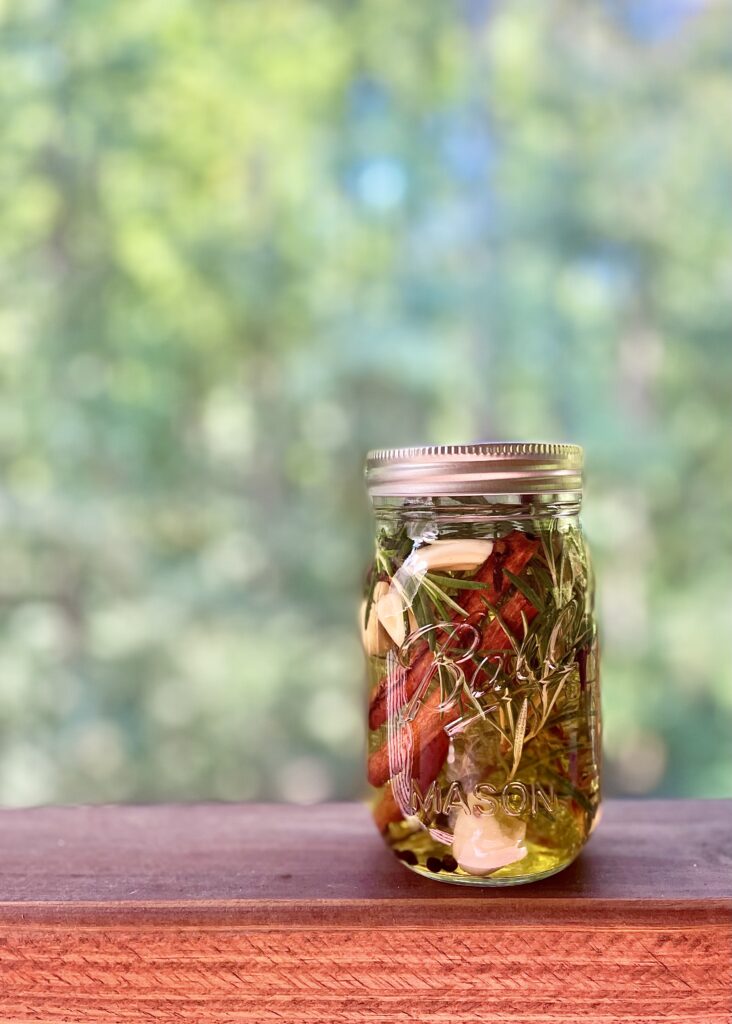
In a pint sized mason jar, combine the following :
- 4 large garlic cloves, peeled and smushed a bit to release their powers 😉
- 4 cinnamon sticks (be sure they aren’t any taller than the jar you’re using)
- 2 large sprigs fresh rosemary
- 8 whole cloves
- 8 whole black peppercorns
Smush the rosemary down and pour the following over :
- Apple cider vinegar to the halfway point of the jar
- White distilled vinegar to the rim of the jar
(You can absolutely use all apple cider vinegar, or if you didn’t have ACV, all plain white like the ‘original recipe’. I like the combination because of the added health benefits of the ACV, but I also want to stay true to tradition by using the plain white. You do you!)
Cover with a coffee filter, or a paper towel would also work, to prevent the metal lid from rusting while in contact with the acidic vinegar.
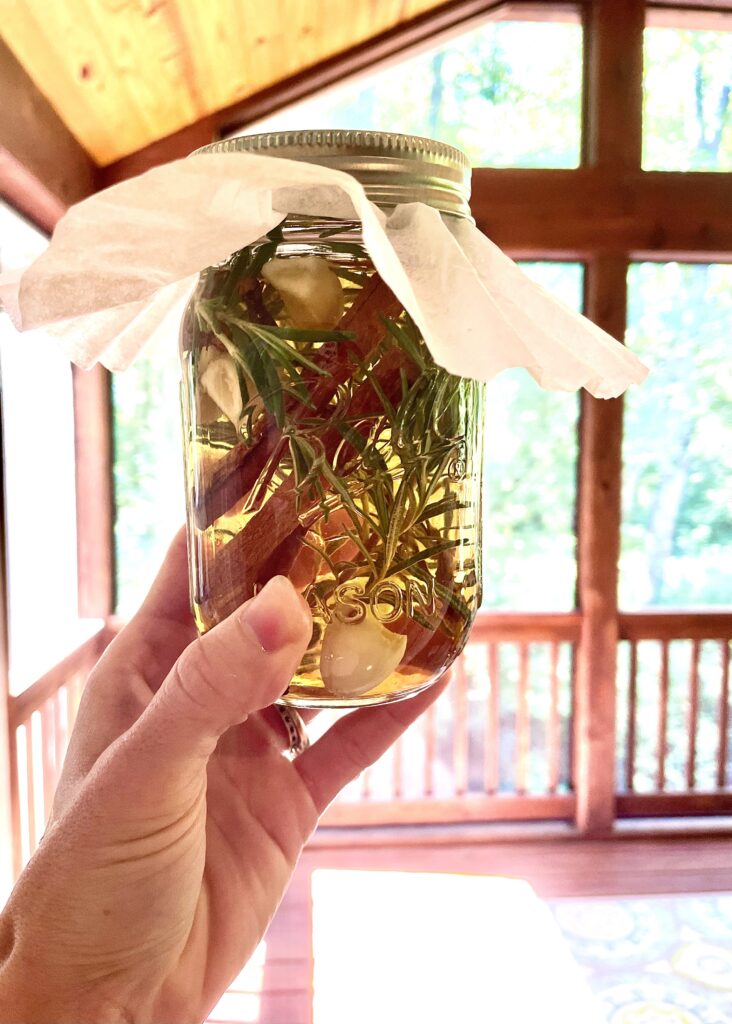
Secure tightly with the jar’s lid.
Place somewhere where the sun can shine on it as much as possible for 4 days (4 again!). (If you don’t have easy access to outdoor sun exposure, find a warm spot indoors! I place mine on my screened-in porch so it’s sort of both).
At this point you can strain it, or leave everything inside. It will only get stronger, but it is definitely ‘done’ after 4 days. (I leave my herbs inside.)
As mentioned before, you can sip it straight if you’re made of clavus like me…
or dilute it to drink it that way!
OR / AND use it in recipes where the flavors make sense to you. You can also apply it topically to spots that may need a bit of antibacterial magick 😉 .
And the rest, my loves, is entirely up to you.
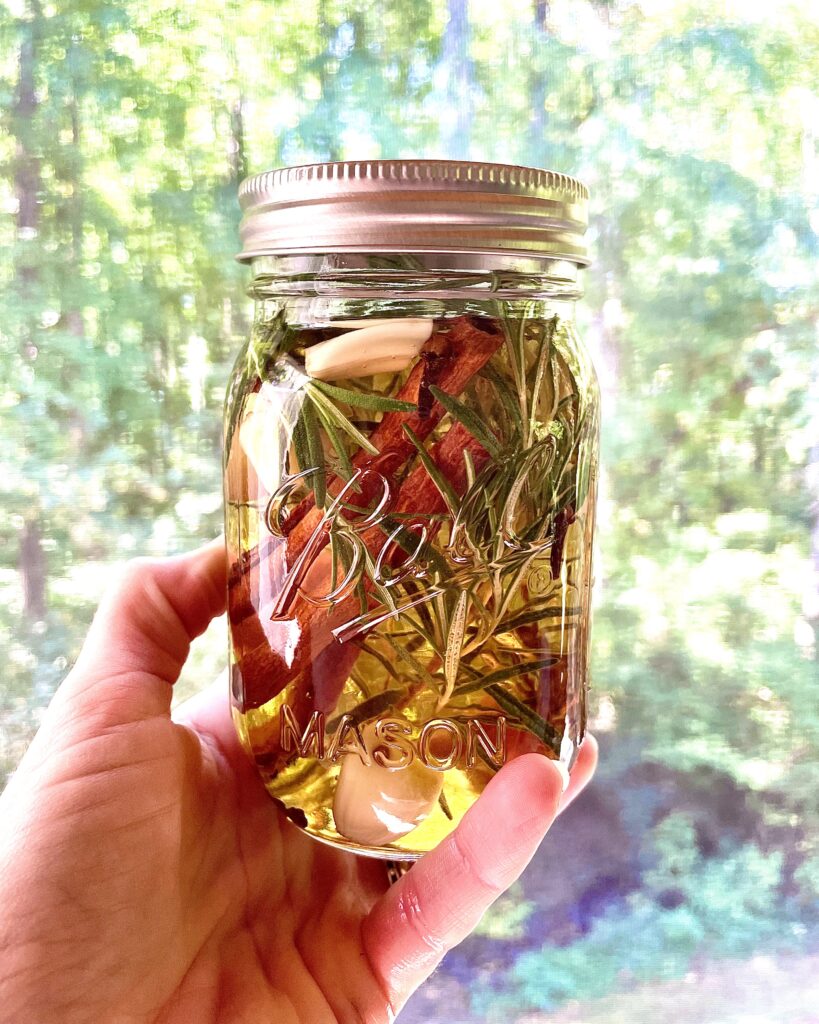
Thanks for reading, ya’ll. Much love xx
If you don’t see me here enough, you can always check Instagram and see what I’m up to over there. Also don’t forget my other hustle, B-Sides. She’s also got herself an Instagram page with some BTS clips, cutting room floor bits, and stand-out moments.
…
Also. I’m not a doctor. 💋


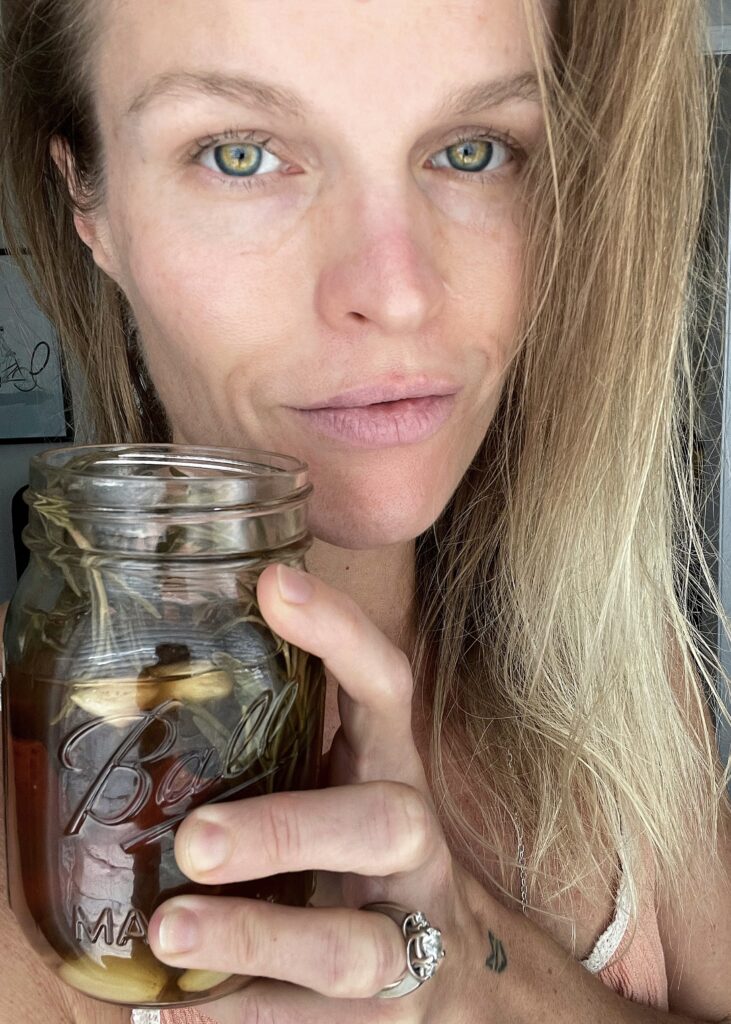
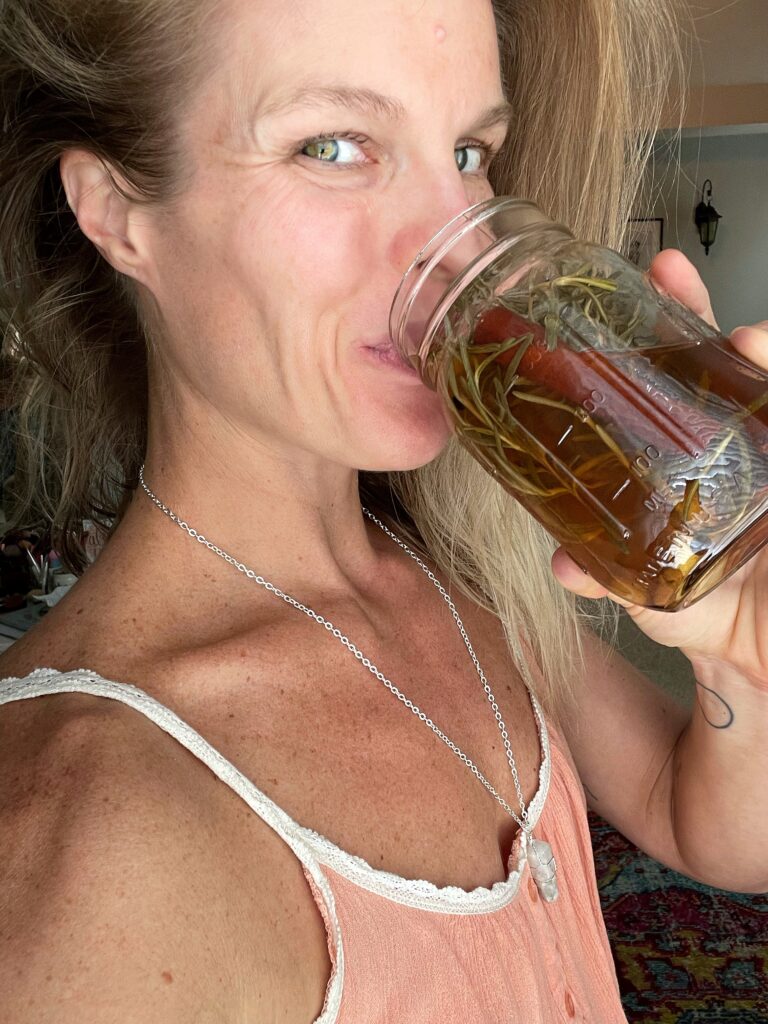
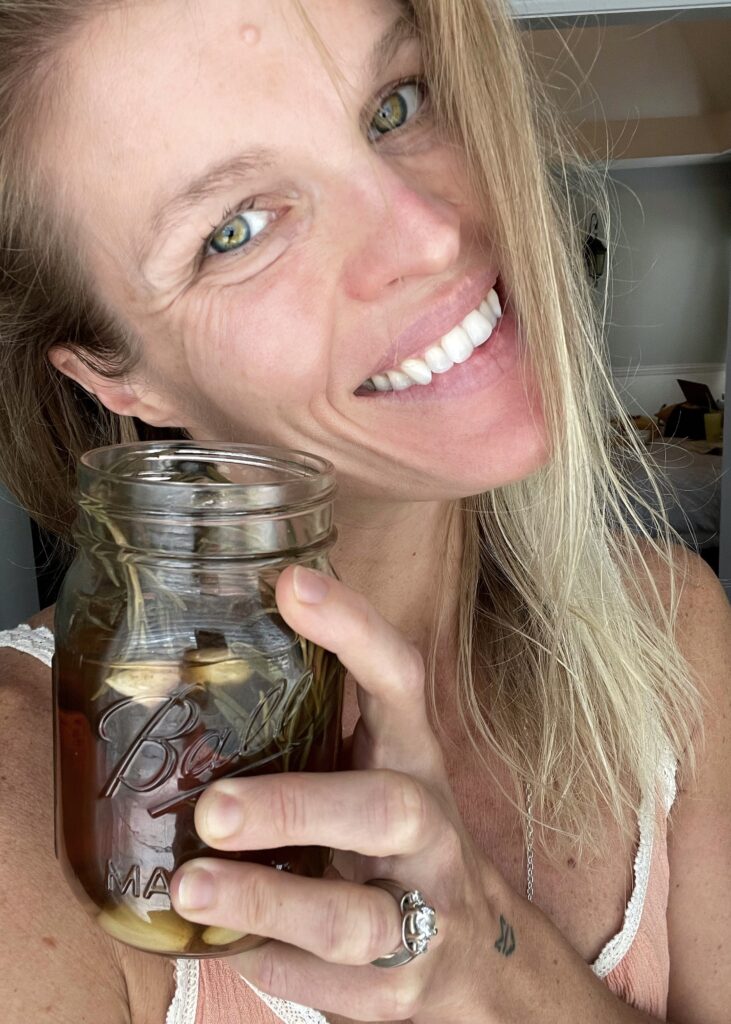


No Comments